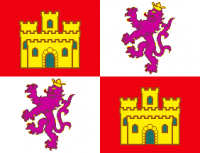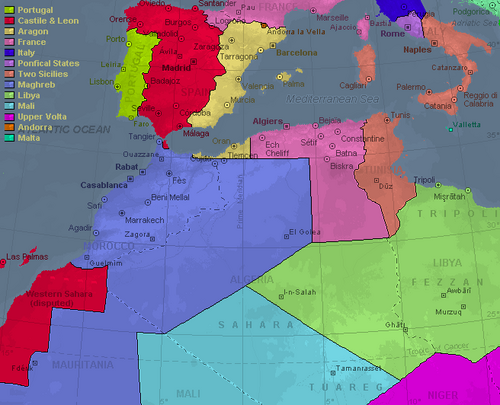Castile and Leon

| |
| National motto: ... | |
| Languages: | |
| Official: | Castilian |
| Others: | Galician, Chibcha, Quichwa, Arabic |
| Cities: | |
| Capital: | Valladolid, Cadiz la Nôva |
| Largest: | Santa Fe |
| Other: | Guatemala, Cádiz, Guayaquil |
| Monarch: | King Alfonso José |
| Prime Minister: | Luis Ignacio Escobar |
| Area: | ... |
| Population: | 103,000,000 Castilians |
| Established: | 1230, By the union of the kingdoms of Castile and Leon |
| Currency: | 1 escudo = 4 pesos duros = 20 pesetas = 240 denarios |
| Organizations: | League of Nations |
This country is usually counted as several countries/nations under one crown. It expands over six continents: Castilian Spain in Europe; the Central American Community in North America; the New Kingdom of Granada in South America; Western Sahara and the Canary Islands in Africa; Corregimiento in Filipinas, Asia; and Guam and Castilian Polynesia in the Pacific. Only in the Antarctic is there no permanent presence of the Kingdom.
Administration
Government
Castile & Leon is a kingdom that extents through Europe, Africa, Central and South America and the Pacific. The European Territory, usually known as Castilian Spain, is on the Iberian Peninsula.
The head of state is King Alfonso José of Castile & Leon, and the chief of state is the Prime Minister, Luis Ignacio Escobar.
Administrative Divisions
The Kingdom of Castile & Leon is divided into four main divisions or nations. These are the Central American Community and the New Kingdom of Granada, each an autonomic community, and Castilian Spain and the Overseas Territories, which are set together for convenience but which are composed of several autonomic communities with no central government overall.
Castilian Spain
Castilian Spain is composed of seven autonomic communities in the Iberian Peninsula, Europe; and one autonomic city, Ceuta, in northern Africa.
Castilian Spain has no central government other than the government of the Kingdom. There is, however, a council, the Spanish Council, which is in charge of the representation of the Spanish people both in the Kingdom, the Castilian Commonwealth and the international community.
Each autonomic community has its own Governor-General' (Gobernador General) and Legislative Assembly (Asamblea Legislativa).
The autonomic communities and the autonomic city are:
- Comunidad Autonómica de Galicia
- Comunidad Autonómica de Asturias
- Comunidad Autonómica de León
- Comunidad Autonómica de Castilla La Veja
- Comunidad Autonómica de Castilla-La Mancha
- Comunidad Autonómica de Extremadura
- Comunidad Autonómica de Andalucía
- Ciudad Autonómica de Ceuta
Central American Community
The Central American Community is divided into five governorships, and it includes the administration of the protectorate of Chiapas.
The governorships and the protectorate are:
- Protectorado de Chiapas
- Gobernación de Guatemala
- Gobernación de Honduras
- Gobernación de Nicaragua
- Gobernación de Costa Rica
- Gobernación de San Andrés y Mosquitos
New Kingdom of Granada
New Granada is further divided in six governorships (gobernaciones) and several provinces (provincias) and communes (municipios).
Each governorship has its own Governor (Gobernador) and Legislative Assembly (Asamblea Legislativa), the provinces have a Provincial Junta (Junta Provincial) which shares legislative and executive powers, and each commune has a Major (Alcalde) and a Communal Council (Concejo Municipal).
The governorships are:
- Gobernación de Panamá
- Gobernación de Antioquia
- Gobernación del Magdalena
- Gobernación de Cundinamarca
- Gobernación de Popayán
- Gobernación de Quito
Overseas Territories (Communities and Colonies)
- Comunidad Autonómica del África y las Canarias
- Gobernación de las Islas Canarias
- Capitanía General del Sahara Occidental
- Comunidad Autonómica del Pacífico Castellano
- Corregimiento de Manila
- Capitanía General de Guam
History
(Main article: History of Castile and Leon)
The Romans established themselves on the Iberian Peninsula after the Punic Wars. At the fall of the Roman Empire, the Peninsula was invaded by Germanic peoples, mainly the Visigoths, which formed a series of Christian, Romance-speaking kingdoms.
In the year of 719, the Moors invaded Spain and in a short time they controlled most of the peninsula.
From France and Asturias several Christian kingdoms established the Reconquista, and slowly drove back the Moors from Spain. Asturias, Leon, Portugal and Navarre soon created new kingdoms such as Castile, Aragon and Valencia.
In 1230, the kingdoms of Castile and Leon were merged forever as Castile and Leon. By this time Leon and Asturias were already merged.
Eventually Navarre, Aragon, Valencia and Barcelona would also be ruled by the same monarch.
The Moorish kingdom in the south, Cordova, was finally defeated in 1492 by the joint effort of the Castilians and Valencians, under the rule of Castile and Leon and Aragon respectively.
That same year, the Kingdom of Castile and Leon sponsored an expedition to reach the Indies by sailing to the west, and they discovered the Americas.
Castile & Leon was the primary agent in the settlement of the Americas, where they founded the viceroyalties of New Leon, Peru and New Granada.
In the 19th century, a series of events in Europe and the Americas provoked the loss of New Leon and Peru, as well as Venezola, Chile and other provinces, till the final independence of Florida, which then grabbed all the Castilian territories in the Caribbean during the 20th century.
In the 20th century, a revolution caused the end of the monarchy, but the monarchy was soon reestablished in the American territories. During a great part of the 20th Century, there were two Castiles: one in Spain (the Republic of Castile, followed by the Castilian State, followed by the restored Kingdom of Castilian Spain) and one in the Americas (the Kingdom of Castile and Leon (overseas)). They were brought together again in 1975.
Since the reunification, Castile & Leon has been advancing in big steps towards a modern nation and trying to forge special ties with the other Castilian-speaking countries, to share culture and technology.
Geography
Castile & Leon is located on the Iberian Peninsula in Europe, northwestern South America, the Central American isthmus, and in western Africa; as well as some islands in the Pacific. For more details please check in:
- Geography of Castilian Spain.
- Geography of the New Kingdom of Granada.
- Geography of Central America.
Borders
European mainland
Castilian Spain is limited by: North: Aragon and the Cantabrian Sea. West: Atlantic Ocean and Portugal. South: Atlantic Ocean, Gibraltar Strait, Gibraltar, and Mediterranean Sea. East: Aragon
South America
The New Kingdom of Granada is limited by: North: Caribbean Sea. West: Central American Community and the Pacific Ocean. South: Peru and Equador. East: Equador and Venezola.
Central America
The Central American Community is limited by: North: Caribbean Sea, and Mejico. West: Chiapas, and the Pacific Ocean. South: Pacific Ocean. East: New Granada, Caribbean Ocean.
| |||
|---|---|---|---|
| National Entities | |||
| Castilian Spain | New Kingdom of Granada | Central American Community | Canary Islands | |||
| Overseas Territories and Colonies | |||
| Castilian Polynesia | Castilian West Africa | Corregimiento de Manila | Guam | |||
| Protectorate | |||
| Chiapas | |||
| Autonomous Cities and the Sovereign Localities | |||
| Ceuta | Peñón de Vélez de la Gomera | Parsley Island (La Isla de Perejil) | Alhucemas Islands | Peñón de Vélez de la Gomera |

